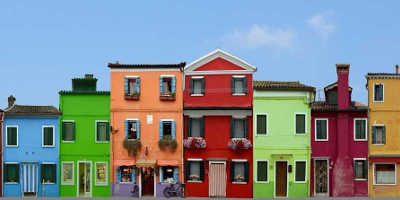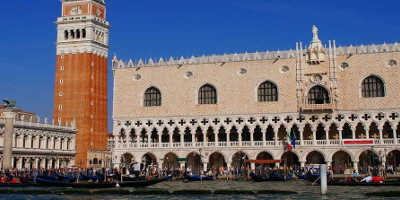Visiting Piazza San Marco
Sitting in the centre of Venice is the famous Piazza San Marco or St Mark’s Square. Locally known simply as la Piazza, the square is a hub of social, political and religious activity.
The square is lined by several key cultural buildings and attractions popular among tourists and locals alike.
Not only is it the largest square in the city, but also by far the largest open space in Venice. The floating city is well known for its winding, narrow laneways and maze of canals. The square is a drastic change from the towering Venetian walls characterising a morning stroll through the city.
The square sits at the end of the Grand Canal and is easily accessed by water taxi. Though you can walk to the square it is worth noting it’s approximately an hour-long walk from the train station, so come prepared.
Palazzo Ducale
Perhaps one of the most famous places in Venice is Doge’s Palace. Built in 1340 the Venetian Gothic palace was the residence of the Doge of Venice, the supreme authority of the Venetian Republic.
The first palace was built in 814, however, it was burnt down in 976. After the fire, it was reconstructed but perished in flames once again. It wasn’t until construction began again in 1340 that the palace seen today emerged. In 1424 the palace undertook further renovations, and two of its facades were expanded. It was at this time that the facades that overlook Piazza San Marco were added. They served as the law-courts for Venice. Almost twenty years later the palace was finally finished.
The palace’s burning history wasn’t over yet though, as yet another fire broke out in 1483. And before you say surely that’s it let us assure you, you are wrong. There would be two most significant fires requiring further reconstruction before the palace would stop burning down. Thankfully, there has been no fire since 1577. Let’s hope it now stays that way!
Visiting Palazzo Ducale
Today, the palace is one of the city’s most recognised and visited attractions. The Palace now operates as a museum and has quite a unique connection with its artworks. The pieces you see here have not been hand-selected to add to a collection, but rather were created specifically for the palace in the 14th and 15th centuries.
The Porta della Carta is the entrance to the palace and is thought to be one of just two perfect examples of Venetian Gothic architecture. Be sure to take time to appreciate the details around the entrance. Once inside the palace do not rush. Not a single detail has been missed by the architects and designers and every inch of the palace is a piece of art in its own right.
Basilica di San Marco
Heading through Porta della Carta you can also entre the magnificent St Mark’s Basilica. The basilica is covered in unbelievably intricate mosaics however its origin is a little less glamourous. Built in the 9th century, the basilica was made to house the corpse of St Mark after merchants smuggled it out of Egypt in a barrel of pork fat.
Unsurprisingly, givens its proximity to the palace, the basilica suffered the same firey fate a few times before becoming what it is today. However, what may surprise you is that the ornate building was the doge’s private chapel and not the Venetian basilica until the republic ended in 1807.
Part of what makes the basilica so unique is that it never shifted to fresco paintings, like those commonly seen in other Catholic churches. Therefore, both the interior and exterior of the basilica are covered in stunning mosaic work. Part of the refusal to shift may be a result of wanting to support the local Murano Glass industry.
Visiting Basilica San Marco
One of the most popular pieces in St Mark’s Basilica is the Pala d’Oro. The stunning altar screen dates back to 1342 and was crafted by a Venetian goldsmith. The structure includes over a thousand pearls and several hundred precious gems. They hold together images of saints, apostles and Christ. The piece is universally recognised as one of the most refined works of Byzantine enamel in the world.
Rialto Bridge
Just a short walk from the plaza is the famous Rialto Bridge. Four bridges cross the Grand Canal and the Rialto is both the oldest and most popular. First built in 1173 the bridge connects the districts of San Marco and San Polo. The bridge was imperative to connecting residents to the nearby Rialto market.
The bridge has been rebuilt several times since 1173, and the stone bridge standing today was completed in 1591. Today, it is one of the most popular tourist attractions in Venice.
People watch in Piazza San Marco
Lining the edges of St Mark’s Square are several cafes. Though expensive they can be the perfect place to sit and people watch. There are often street performers here and the square transforms for several festivals and events throughout the year.
If you’re visiting for Carnevale, head into the square early and grab a table outside, ready to watch as people parade their costumes through the square. During the winter annual floods hit the square, and though they can put a dampener on moods, there is no more Venetian experience than standing in St Mark’s Square with your gumboots on.
During the year you can often spot street performers in the street performing for tourists.
With so much to see in Piazza San Marco, you could easily spend a whole day just in one spot! Be sure to return in the evening as the sun sets to see the mosaics light up with a golden glow. We visit Piazza San Marco on all our Venice tours, so be sure to book your spot today!
Related article: What Are Different Styles Of Architecture In Venice?










